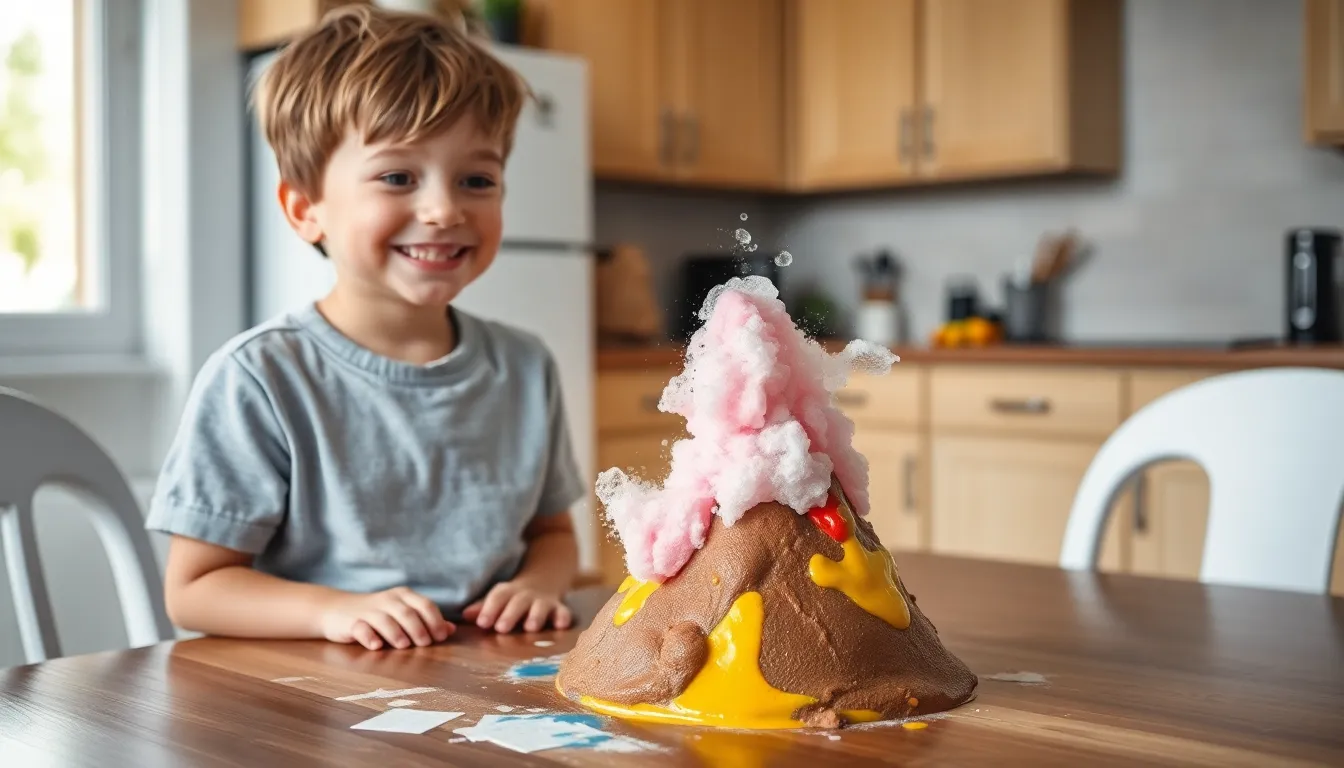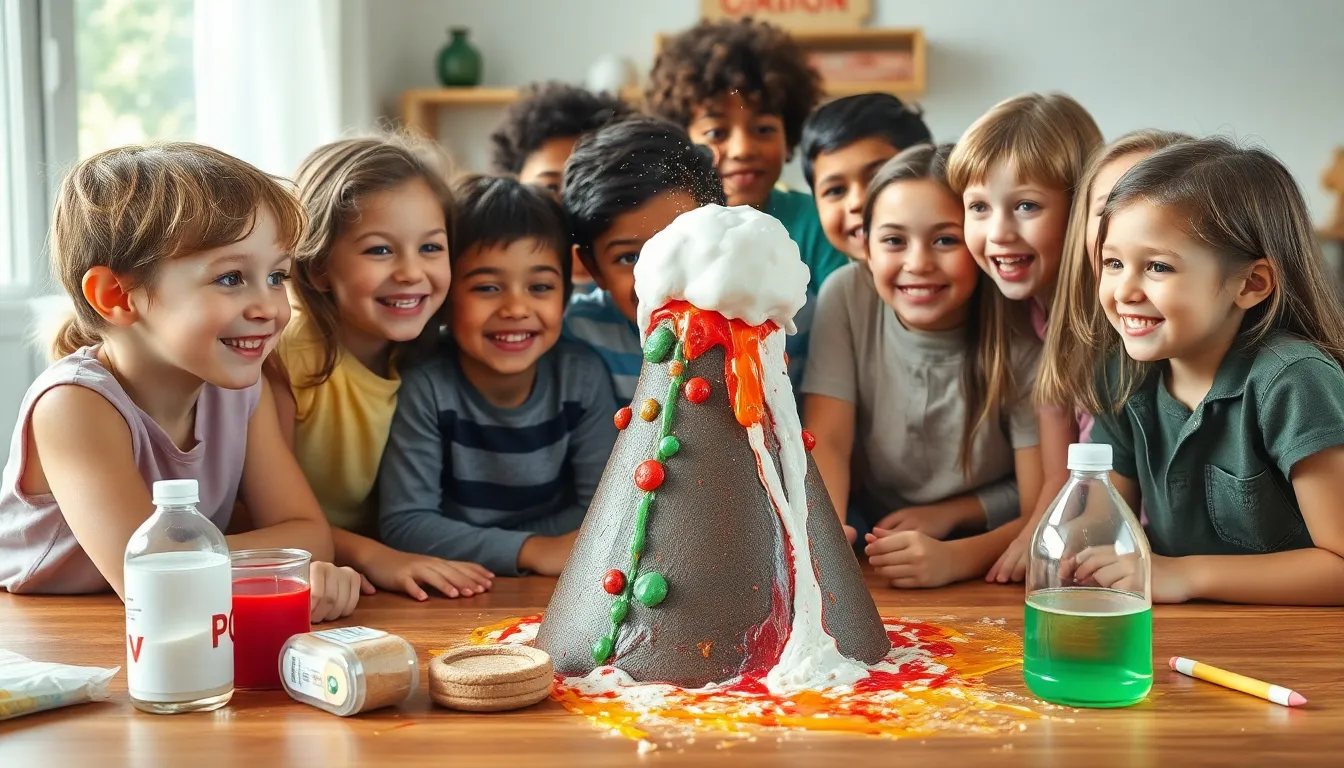Who said science can’t be a blast? Homemade volcano experiments bring the thrill of eruption right into the comfort of your kitchen. With just a few simple ingredients, anyone can unleash their inner mad scientist and watch as a colorful lava flow bursts forth like a mini Mount St. Helens. It’s not just fun; it’s a fantastic way to learn about chemical reactions and the power of nature.
Table of Contents
ToggleOverview of Homemade Volcano Science
Homemade volcano science offers a captivating way to explore geological processes. Experiments provide hands-on experiences that reveal the beauty of chemical reactions. Simple household materials, like baking soda and vinegar, create impressive eruptions, mimicking volcanic activity. Engaging in these activities sparks curiosity about natural phenomena.
Learning about volcanoes deepens understanding of Earth’s structures. Eruptions serve as practical demonstrations of concepts like pressure and gas release. Participants witness the transformation as liquids become bubbling lava before their eyes. For many, this adds an element of excitement to scientific education.
Safety remains a priority when conducting experiments. Adult supervision ensures a safe environment, particularly for younger participants. Wearing safety goggles protects eyes from splashes during eruptions. Using trays or large pans helps contain messes and simplifies cleanup.
Several variations exist for homemade volcano experiments. While classic baking soda and vinegar setups are popular, options like dish soap and food coloring enhance visual effects. Experimenting with different ratios produces unique eruption dynamics, encouraging creativity.
Using scientific principles, observers analyze results and improve experiments. Tracking size, eruption duration, and color variations adds a data-driven aspect. Documenting findings enhances critical thinking skills and encourages verbal communication of science.
Homemade volcano science serves as both fun and educational. Those who participate develop a passion for learning about Earth science. Engaging in these projects fosters teamwork and collaborative learning. Everyone involved gains valuable insights into the fascinating world of volcanology.
Materials Needed for Homemade Volcanoes
Creating a homemade volcano requires basic materials, many of which can be found around the house. Using these simple ingredients makes it easy for anyone to join in on the fun of scientific exploration.
Common Household Items
Baking soda acts as the primary ingredient for your eruption. When combined with vinegar, this base creates an impressive foaming reaction. A container, like a plastic bottle or a paper cup, provides the structure for the volcano. Food coloring adds vibrant colors to the lava, enhancing the visual excitement. For realistic effects, clay or playdough shapes the volcano’s exterior. Water mixes with other ingredients to control the lava’s flow and intensity.
Optional Add-Ons
Experimenters can enhance their volcano projects using optional materials. Corn syrup can create a thicker, more syrupy lava for a unique look. Glitter serves to resemble volcanic ash, adding to the visual appeal. Activated charcoal can simulate soot, providing an authentic touch to the volcanic activity. Using essential oils introduces captivating scents, enriching the experience. Lastly, miniature figurines can represent an environment around the volcano, fostering creative storytelling alongside the scientific investigation.
Step-by-Step Guide to Creating a Volcano
Creating a homemade volcano involves simple steps that lead to an exciting eruption. Below are details on building the volcano structure and preparing the eruption mixture.
Building the Volcano Structure
Select a sturdy base like a tray or cardboard. This ensures stability during eruptions. For the volcano shape, use a plastic bottle as the core. Mound clay or playdough around the base to create a mountain effect. The height and shape can vary based on personal preference. Incorporate a crater at the top to allow for easier eruption. Food coloring can be mixed into the clay for a colorful effect. Participants might also use paper cups as an alternative if clay isn’t available.
Preparing the Eruption Mixture
Combine baking soda and vinegar for the eruption. Fill the bottle two-thirds full with vinegar. Measure about two tablespoons of baking soda, then add it directly into the vinegar. For a vibrant eruption, include several drops of food coloring. Mix it gently to avoid excessive fizzing before the reaction. If desired, incorporate corn syrup to thicken the lava. This creates a slower, more dramatic flow. Experimenting with additional materials enhances the eruption’s visual appeal and provides varied scientific outcomes.
Understanding the Science Behind Volcanoes
Homemade volcano experiments reveal fascinating scientific principles. They illustrate how chemical reactions create eruptions and mimic natural volcanic activities.
Chemical Reactions Involved
Baking soda and vinegar create an acid-base reaction. This reaction produces carbon dioxide gas, resulting in bubbles and pressure buildup. As the gas expands, it forces the liquid mixture to erupt. Experimenters can enhance eruptions by adjusting the amounts of baking soda or vinegar. Each modification changes the intensity and duration of the eruption, offering valuable insights into reaction dynamics. Understanding these principles helps explain real-world volcanic eruptions, where gases and magma lead to explosive events.
Real-World Volcanoes Compared
Natural volcanoes demonstrate similar eruption processes. Magma beneath the Earth’s surface behaves like the mixture participants create. Pressure from gases in magma causes eruptions when surfaces fail to contain the buildup. Different types of eruptions exist, including explosive and effusive events. Mount St. Helens, for instance, showcases a powerful explosive eruption, while Kilauea is known for its gentle lava flows. Comparing these volcanoes to homemade experiments fosters a deeper understanding of geological phenomena. Making these comparisons illuminates complexities within Earth’s geology and enriches the learning experience.
Safety Precautions to Consider
Safety remains a top priority when conducting homemade volcano experiments. Adult supervision is essential, especially for younger participants. Protective gear, such as safety goggles and gloves, ensures everyone stays safe during the eruption process.
When working with baking soda and vinegar, keep the workspace covered with newspaper or a plastic sheet. Clean-up becomes easier, and it minimizes mess. Participants must avoid ingesting any materials used in the experiments. Both baking soda and vinegar are safe when used correctly, but it’s important to keep them away from the eyes and mouth.
Ventilation plays a significant role in safety. Conduct experiments in well-ventilated areas to disperse any gas released during the eruption. Clear the workspace of any unnecessary items to reduce the risk of spills or accidents.
Experimenters should also prepare for potential spills by having paper towels or a cloth on hand. When combining ingredients, it’s best to start with small amounts to gauge reactions. This practice prevents any overflow or unexpected reactions that might occur.
For an enhanced experience, it’s wise to choose a stable surface for the volcano setup. This approach minimizes the risk of knocking over the volcano, especially during vigorous eruptions.
Finally, ensure participants understand the importance of safety before starting. Emphasizing these precautions not only increases safety but also enriches the learning environment. Prioritizing safety creates a more enjoyable exploration of homemade volcano science.
Conclusion
Homemade volcano experiments offer a thrilling way to explore science while having fun. These hands-on activities not only entertain but also educate about chemical reactions and natural processes. By using simple household items, anyone can create impressive eruptions that spark curiosity about the world around them.
Safety remains a priority, ensuring that participants can enjoy their experiments without worry. With creativity and experimentation, these volcano projects can ignite a passion for Earth science. Whether it’s adjusting ingredients for different effects or adding unique visual elements, the possibilities are endless. Engaging in homemade volcano science fosters collaboration and critical thinking, making it a valuable experience for learners of all ages.









